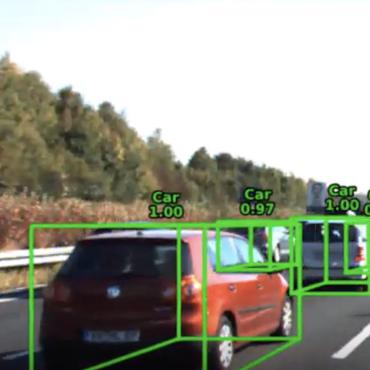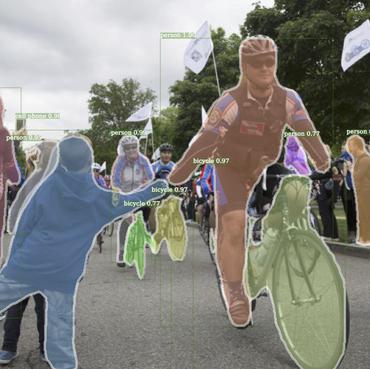Search Results for author: Mahyar Najibi
Found 30 papers, 12 papers with code
CatLIP: CLIP-level Visual Recognition Accuracy with 2.7x Faster Pre-training on Web-scale Image-Text Data
1 code implementation • 24 Apr 2024 • Sachin Mehta, Maxwell Horton, Fartash Faghri, Mohammad Hossein Sekhavat, Mahyar Najibi, Mehrdad Farajtabar, Oncel Tuzel, Mohammad Rastegari
Contrastive learning has emerged as a transformative method for learning effective visual representations through the alignment of image and text embeddings.
OpenELM: An Efficient Language Model Family with Open-source Training and Inference Framework
1 code implementation • 22 Apr 2024 • Sachin Mehta, Mohammad Hossein Sekhavat, Qingqing Cao, Maxwell Horton, Yanzi Jin, Chenfan Sun, Iman Mirzadeh, Mahyar Najibi, Dmitry Belenko, Peter Zatloukal, Mohammad Rastegari
To this end, we release OpenELM, a state-of-the-art open language model.
Superposition Prompting: Improving and Accelerating Retrieval-Augmented Generation
no code implementations • 10 Apr 2024 • Thomas Merth, Qichen Fu, Mohammad Rastegari, Mahyar Najibi
Despite the successes of large language models (LLMs), they exhibit significant drawbacks, particularly when processing long contexts.
Speculative Streaming: Fast LLM Inference without Auxiliary Models
no code implementations • 16 Feb 2024 • Nikhil Bhendawade, Irina Belousova, Qichen Fu, Henry Mason, Mohammad Rastegari, Mahyar Najibi
Speculative decoding is a prominent technique to speed up the inference of a large target language model based on predictions of an auxiliary draft model.
Unsupervised 3D Perception with 2D Vision-Language Distillation for Autonomous Driving
no code implementations • ICCV 2023 • Mahyar Najibi, Jingwei Ji, Yin Zhou, Charles R. Qi, Xinchen Yan, Scott Ettinger, Dragomir Anguelov
Closed-set 3D perception models trained on only a pre-defined set of object categories can be inadequate for safety critical applications such as autonomous driving where new object types can be encountered after deployment.
3D Human Keypoints Estimation From Point Clouds in the Wild Without Human Labels
no code implementations • CVPR 2023 • Zhenzhen Weng, Alexander S. Gorban, Jingwei Ji, Mahyar Najibi, Yin Zhou, Dragomir Anguelov
We show that by training on a large training set from Waymo Open Dataset without any human annotated keypoints, we are able to achieve reasonable performance as compared to the fully supervised approach.
GINA-3D: Learning to Generate Implicit Neural Assets in the Wild
no code implementations • CVPR 2023 • Bokui Shen, Xinchen Yan, Charles R. Qi, Mahyar Najibi, Boyang Deng, Leonidas Guibas, Yin Zhou, Dragomir Anguelov
Modeling the 3D world from sensor data for simulation is a scalable way of developing testing and validation environments for robotic learning problems such as autonomous driving.
Improving the Intra-class Long-tail in 3D Detection via Rare Example Mining
no code implementations • 15 Oct 2022 • Chiyu Max Jiang, Mahyar Najibi, Charles R. Qi, Yin Zhou, Dragomir Anguelov
Continued improvements in deep learning architectures have steadily advanced the overall performance of 3D object detectors to levels on par with humans for certain tasks and datasets, where the overall performance is mostly driven by common examples.
Motion Inspired Unsupervised Perception and Prediction in Autonomous Driving
no code implementations • 14 Oct 2022 • Mahyar Najibi, Jingwei Ji, Yin Zhou, Charles R. Qi, Xinchen Yan, Scott Ettinger, Dragomir Anguelov
Learning-based perception and prediction modules in modern autonomous driving systems typically rely on expensive human annotation and are designed to perceive only a handful of predefined object categories.
Revisiting 3D Object Detection From an Egocentric Perspective
no code implementations • NeurIPS 2021 • Boyang Deng, Charles R. Qi, Mahyar Najibi, Thomas Funkhouser, Yin Zhou, Dragomir Anguelov
Given the insight that SDE would benefit from more accurate geometry descriptions, we propose to represent objects as amodal contours, specifically amodal star-shaped polygons, and devise a simple model, StarPoly, to predict such contours.
Offboard 3D Object Detection from Point Cloud Sequences
no code implementations • CVPR 2021 • Charles R. Qi, Yin Zhou, Mahyar Najibi, Pei Sun, Khoa Vo, Boyang Deng, Dragomir Anguelov
While current 3D object recognition research mostly focuses on the real-time, onboard scenario, there are many offboard use cases of perception that are largely under-explored, such as using machines to automatically generate high-quality 3D labels.
Scale Normalized Image Pyramids with AutoFocus for Object Detection
1 code implementation • 10 Feb 2021 • Bharat Singh, Mahyar Najibi, Abhishek Sharma, Larry S. Davis
The resulting algorithm is referred to as AutoFocus and results in a 2. 5-5 times speed-up during inference when used with SNIP.
ASAP-NMS: Accelerating Non-Maximum Suppression Using Spatially Aware Priors
1 code implementation • 19 Jul 2020 • Rohun Tripathi, Vasu Singla, Mahyar Najibi, Bharat Singh, Abhishek Sharma, Larry Davis
The widely adopted sequential variant of Non Maximum Suppression (or Greedy-NMS) is a crucial module for object-detection pipelines.
DOPS: Learning to Detect 3D Objects and Predict their 3D Shapes
no code implementations • CVPR 2020 • Mahyar Najibi, Guangda Lai, Abhijit Kundu, Zhichao Lu, Vivek Rathod, Thomas Funkhouser, Caroline Pantofaru, David Ross, Larry S. Davis, Alireza Fathi
In contrast, we propose a general-purpose method that works on both indoor and outdoor scenes.
Adversarial Training for Free!
6 code implementations • NeurIPS 2019 • Ali Shafahi, Mahyar Najibi, Amin Ghiasi, Zheng Xu, John Dickerson, Christoph Studer, Larry S. Davis, Gavin Taylor, Tom Goldstein
Adversarial training, in which a network is trained on adversarial examples, is one of the few defenses against adversarial attacks that withstands strong attacks.
An Analysis of Pre-Training on Object Detection
no code implementations • 11 Apr 2019 • Hengduo Li, Bharat Singh, Mahyar Najibi, Zuxuan Wu, Larry S. Davis
We analyze how well their features generalize to tasks like image classification, semantic segmentation and object detection on small datasets like PASCAL-VOC, Caltech-256, SUN-397, Flowers-102 etc.
FA-RPN: Floating Region Proposals for Face Detection
no code implementations • CVPR 2019 • Mahyar Najibi, Bharat Singh, Larry S. Davis
We propose a novel approach for generating region proposals for performing face-detection.
AutoFocus: Efficient Multi-Scale Inference
1 code implementation • ICCV 2019 • Mahyar Najibi, Bharat Singh, Larry S. Davis
Instead of processing an entire image pyramid, AutoFocus adopts a coarse to fine approach and only processes regions which are likely to contain small objects at finer scales.
Universal Adversarial Training
no code implementations • 27 Nov 2018 • Ali Shafahi, Mahyar Najibi, Zheng Xu, John Dickerson, Larry S. Davis, Tom Goldstein
Standard adversarial attacks change the predicted class label of a selected image by adding specially tailored small perturbations to its pixels.
Generate, Segment and Refine: Towards Generic Manipulation Segmentation
1 code implementation • 24 Nov 2018 • Peng Zhou, Bor-Chun Chen, Xintong Han, Mahyar Najibi, Abhinav Shrivastava, Ser Nam Lim, Larry S. Davis
The advent of image sharing platforms and the easy availability of advanced photo editing software have resulted in a large quantities of manipulated images being shared on the internet.
Soft Sampling for Robust Object Detection
1 code implementation • 18 Jun 2018 • Zhe Wu, Navaneeth Bodla, Bharat Singh, Mahyar Najibi, Rama Chellappa, Larry S. Davis
Interestingly, we observe that after dropping 30% of the annotations (and labeling them as background), the performance of CNN-based object detectors like Faster-RCNN only drops by 5% on the PASCAL VOC dataset.
SNIPER: Efficient Multi-Scale Training
4 code implementations • NeurIPS 2018 • Bharat Singh, Mahyar Najibi, Larry S. Davis
Our implementation based on Faster-RCNN with a ResNet-101 backbone obtains an mAP of 47. 6% on the COCO dataset for bounding box detection and can process 5 images per second during inference with a single GPU.
 Ranked #113 on
Object Detection
on COCO test-dev
Ranked #113 on
Object Detection
on COCO test-dev
Poison Frogs! Targeted Clean-Label Poisoning Attacks on Neural Networks
6 code implementations • NeurIPS 2018 • Ali Shafahi, W. Ronny Huang, Mahyar Najibi, Octavian Suciu, Christoph Studer, Tudor Dumitras, Tom Goldstein
The proposed attacks use "clean-labels"; they don't require the attacker to have any control over the labeling of training data.
Face-MagNet: Magnifying Feature Maps to Detect Small Faces
1 code implementation • 14 Mar 2018 • Pouya Samangouei, Mahyar Najibi, Larry Davis, Rama Chellappa
In this paper, we introduce the Face Magnifier Network (Face-MageNet), a face detector based on the Faster-RCNN framework which enables the flow of discriminative information of small scale faces to the classifier without any skip or residual connections.
SSH: Single Stage Headless Face Detector
6 code implementations • ICCV 2017 • Mahyar Najibi, Pouya Samangouei, Rama Chellappa, Larry Davis
Surprisingly, with a headless VGG-16, SSH beats the ResNet-101-based state-of-the-art on the WIDER dataset.
Towards the Success Rate of One: Real-time Unconstrained Salient Object Detection
no code implementations • 31 Jul 2017 • Mahyar Najibi, Fan Yang, Qiaosong Wang, Robinson Piramuthu
In this work, we propose an efficient and effective approach for unconstrained salient object detection in images using deep convolutional neural networks.
Supervised Incremental Hashing
no code implementations • 25 Apr 2016 • Bahadir Ozdemir, Mahyar Najibi, Larry S. Davis
In the first stage of classification, binary codes are considered as class labels by a set of binary SVMs; each corresponds to one bit.
G-CNN: an Iterative Grid Based Object Detector
no code implementations • CVPR 2016 • Mahyar Najibi, Mohammad Rastegari, Larry S. Davis
G-CNN starts with a multi-scale grid of fixed bounding boxes.
On Large-Scale Retrieval: Binary or n-ary Coding?
no code implementations • 20 Sep 2015 • Mahyar Najibi, Mohammad Rastegari, Larry S. Davis
To make large-scale search feasible, Distance Estimation and Subset Indexing are the main approaches.
Local Similarities, Global Coding: An Algorithm for Feature Coding and its Applications
no code implementations • 24 Nov 2013 • Amirreza Shaban, Hamid R. Rabiee, Mahyar Najibi
Data coding as a building block of several image processing algorithms has been received great attention recently.














